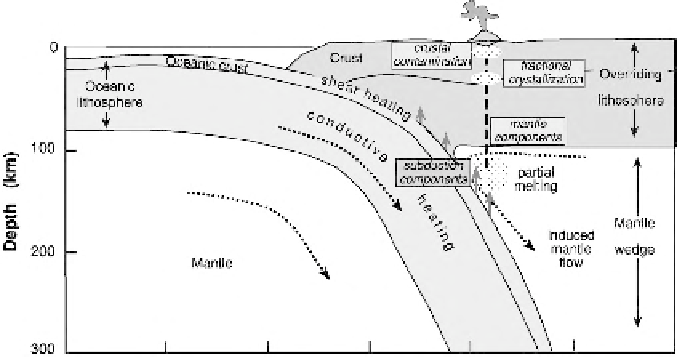Geoscience Reference
In-Depth Information
Figure 10.9.
A cross section of a subduction zone, showing the main factors and
processes which control its thermal structure and the volcanic arc. The age and rate
of subduction of the oceanic plate, as well as the dip and amount of shear heating,
are important factors controlling the thermal structure. The loss of water and
volatiles from the downgoing oceanic plate causes melting in the mantle wedge.
The melt is contaminated and fractionated during ascent through the overriding
lithosphere. (Based on Pearce (1983).)
over 350 000 yr. Shallower melting in the wedge, at depths of 60-90 km, would
produce liquids that may be parental to basaltic andesite. Andesite, which is the
commonest magma erupted from arc volcanoes, cannot be directly produced by
melting of the mantle wedge except by melting of very wet (about 15% H
2
O)
mantle peridotite at depths of about 40 km, or under other very restricted circum-
stances. Most probably, the fluids from the subducted slab promote melting of the
mantle wedge, producing basic melts that rise because they are lighter than the
surrounding residual peridotite and eventually reach the base of the continental
crust.
The whole subduction melt system can be thought of as a conveyor belt emit-
ting volumes of melt that rise upwards: warm mantle convects into place above
the subduction zone; fluid enters from the slab below and initiates melting; melt
escapes upwards; the residual mantle is carried away by convection; and new
warm material takes its place.
The base of the continental crust
Partial melts generated in the mantle wedge rise either as diapirs of melt and crys-
tals, which increasingly melt and become more basic as they rise and decompress,
or as rapidly moving segregated melt. The rising melt probably follows a nearly
adiabatic pressure-temperature path in a mature subduction system, cooling by
up to 1
◦
Ckm
−
1
(this is the adiabatic gradient in a magmatic liquid, in contrast
to 0.5
◦
Ckm
−
1
in solid mantle). Much depends on the release of latent heat. At

